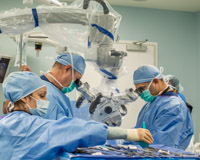Sciatica is a term used to describe symptoms rather than a specific medical condition. It’s typically caused by irritation or compression of the sciatic nerve, which is the largest nerve in the body that runs from the lower back down the back of each leg. Sciatica symptoms – such as pain, numbness and muscle weakness in the affected leg – are often caused by problems with your lower spine, such as a herniated disc or a bone spur.
Sciatica Symptoms:
The most common symptoms of sciatica include:
- Pain: Sciatic pain often begins in the lower back and radiates down one leg. It can be sharp, shooting, or burning, and typically follows the path of the sciatic nerve.
- Numbness and Tingling: You may experience numbness or a tingling sensation in the leg or foot when dealing with sciatica, which can make it difficult to discern between hot and cold temperatures or distinguish between different textures.
- Muscle Weakness: Muscle weakness from nerve compression or damage can happen, making it challenging to walk or lift objects.
- Radiating Pain: Originating in your lower back, sciatica pain can radiate down your hips, buttocks, legs, and even into your feet.
Sciatica Treatment:
Sciatica is commonly caused by several factors, including:
- Herniated Disc: A herniated or slipped disc can press on the sciatic nerve.
- Spinal Stenosis: Narrowing of the spinal canal can compress the nerve.
- Spondylolisthesis: The nerve can be pinched when one vertebra slips over another.
- Piriformis Syndrome: The piriformis muscle, located in the buttocks, can also compress the sciatic nerve.
Sciatica can often be treated through non-surgical methods such as:
- Rest and avoiding activities that exacerbate symptoms
- Anti-inflammatory medications
- Muscle relaxants
- Applying heat/ice
- Physical therapy
- Epidural steroid injections for more severe cases to help decrease inflammation directly around the nerve.
However, if your pain remains despite these interventions, surgery may be the logical next step. Microdiscectomies and lumbar laminectomies, two of the most common surgeries for sciatica, can be performed using minimally invasive techniques with quicker recovery times and fewer complications. In fact, many patients are able to get out of bed within the day and report significant pain relief within weeks.
Sciatica Recovery:
Recovery from sciatica varies based on the individual and the treatment provided, but in many cases, people experience relief from symptoms within a few weeks of treatment. With the non-surgical and minimally invasive options at DISC, recovery is quicker and relief is right around the corner.
It's important to work closely with a healthcare professional to determine the most appropriate treatment plan and ensure a safe and effective recovery. Schedule a consultation with one of our world-renowned spine specialists today to learn more about your options and take the steps to get relief from sciatica pain.
Video: Sciatica Patient, Donald
Hear from Donald, who’s stenosis caused him to suffer from severe sciatica. With DISC’s treatment, he was able to recover from immobility and pain (including sciatica) caused by stenosis.

About the author
discmdgroup DISC Sports & Spine Center (DISC) is a national leader in minimally invasive spine surgery, orthopedic surgery, and sports medicine care. Our spine surgeons set the standard in artificial disc replacement, spine fusion, discectomy, microdiscectomy and the full spectrum of spine procedures. The group’s orthopedic surgeons advance the state of joint preservation surgery and total joint replacement, including total knee replacement as well as total hip replacement. Our flagship surgery centers based in Newport Beach, Marina del Rey, and Carlsbad serve patients local to Los Angeles, Orange County and San Diego, as well as the rest of the country. Read more articles by discmdgroup.





